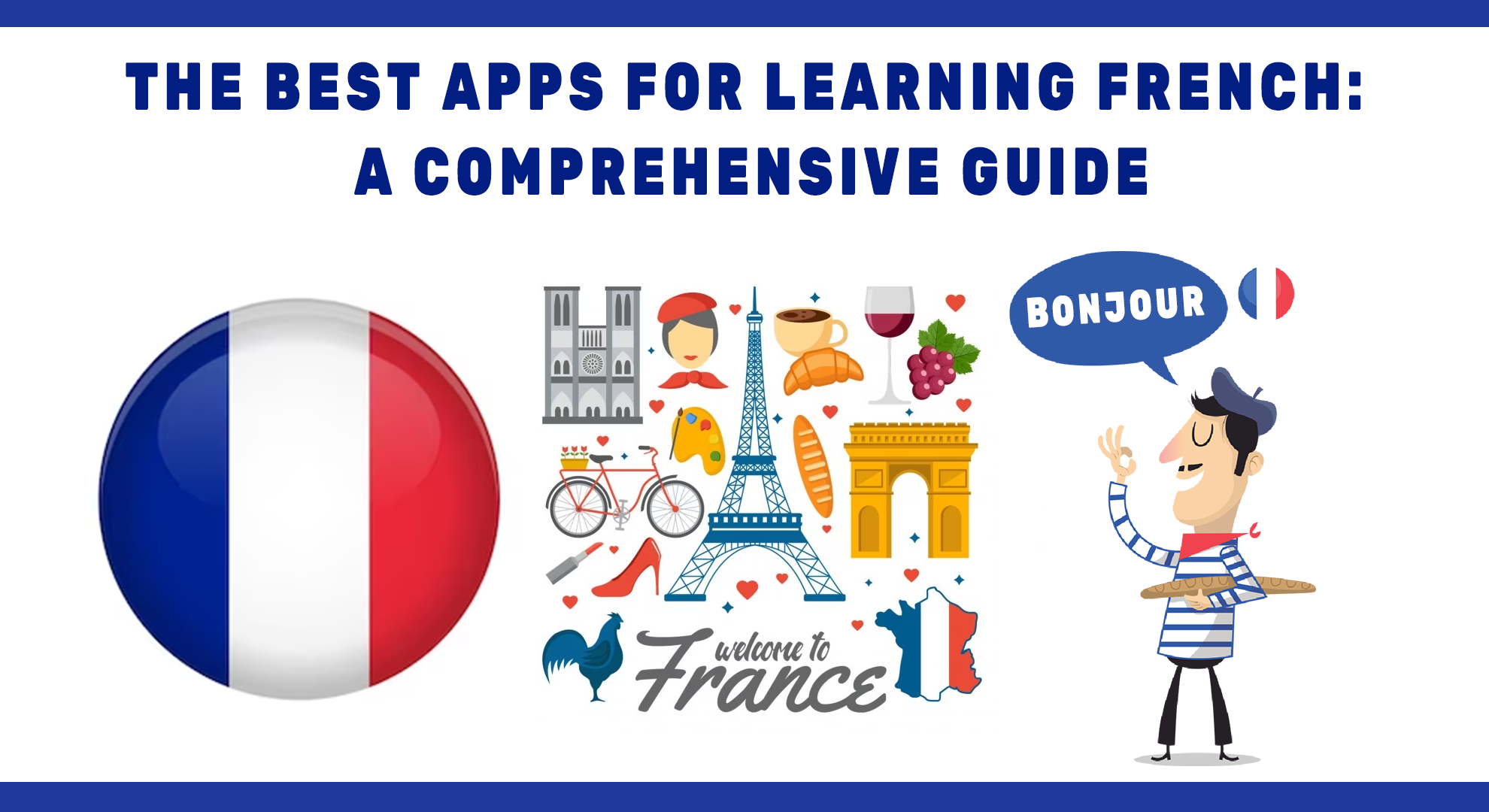Learning French has never been more accessible, thanks to the plethora of language learning apps available. Whether you’re a beginner or looking to enhance your proficiency, these apps cater to various learning styles and preferences. In this guide, we’ll explore the top apps for mastering the French language, outlining their pros and cons to help you make an informed choice.
1. Duolingo
Duolingo stands out as one of the most popular and user-friendly language learning platforms globally. Launched in 2011, it has gained immense popularity due to its innovative approach, making language acquisition an engaging and enjoyable experience.
Website: Duolingo
Key Features
- Gamified Learning:
- Duolingo incorporates gamification elements, turning language learning into a fun and interactive experience. Learners earn points, tackle challenges, and progress through levels, creating a sense of achievement.
- Bite-Sized Lessons:
- The platform offers short, easily digestible lessons that cater to daily practice. This structure is ideal for learners with busy schedules, allowing them to fit language learning into their routines.
- Multimodal Approach:
- Duolingo employs a multimodal approach, covering various aspects of language learning. It includes exercises for vocabulary, grammar, speaking, listening, and even writing, ensuring a holistic learning experience.
- Adaptive Learning:
- The platform adapts to each learner’s performance, offering personalized challenges based on strengths and weaknesses. This adaptive learning model ensures that learners progress at their own pace.
- Community Engagement:
- Duolingo has a community feature where learners can interact, discuss language-related topics, and participate in forums. This social aspect adds an extra layer of engagement, fostering a sense of belonging among language enthusiasts.
- Mobile Accessibility:
- Duolingo is highly accessible, available as a mobile app for both Android and iOS platforms. This flexibility enables users to learn on the go, making it convenient for those with busy lifestyles.
Pros:
- Free Accessibility: Duolingo is predominantly free, making it accessible to a wide range of users.
- User-Friendly Interface: The platform’s intuitive design makes it easy for learners of all ages and technological proficiency.
- Engaging and Fun: The gamified structure keeps learners motivated and entertained, enhancing overall retention.
- Regular Updates: Duolingo frequently updates its content, ensuring relevance and incorporating user feedback.
Cons:
- Limited Depth in Grammar Explanation: While effective for beginners, Duolingo might not provide in-depth explanations for complex grammar rules.
- Overemphasis on Repetition: Some users find that the platform relies heavily on repetition, potentially becoming monotonous for some learners.
- Lack of Cultural Context: Duolingo’s focus is primarily on language skills, and it might not provide extensive cultural insights associated with language learning.
Duolingo’s success lies in its ability to merge education with entertainment, making language learning enjoyable for millions worldwide. Whether you’re a beginner or looking to brush up on your language skills, Duolingo’s innovative approach and user-friendly interface offer an effective way to embark on your language learning journey.
2. Babbel
Babbel is a versatile language learning platform designed to cater to the needs of language enthusiasts seeking a practical and personalized approach. Launched in 2007, Babbel has since become a prominent player in the online language education space.
Website: Babbel
Key Features
- Practical Language Skills:
- Babbel focuses on practical language skills, emphasizing real-life conversations and scenarios. This approach ensures that learners acquire language proficiency that is immediately applicable in various situations.
- Tailored Lessons:
- Babbel tailors its lessons based on your native language, recognizing that different languages pose unique challenges for learners. This personalized approach facilitates a smoother learning experience.
- Speech Recognition:
- The platform includes a speech recognition feature that helps learners improve their pronunciation. This interactive element ensures that learners not only understand the language but can also articulate it effectively.
- Structured Courses:
- Babbel offers structured courses covering grammar, vocabulary, and practical dialogues. The progression is logical and allows learners to build a solid foundation before moving on to more complex language concepts.
- Real-Life Conversations:
- Babbel incorporates real-life dialogues to provide learners with authentic language exposure. This feature enhances listening skills and acquaints learners with natural language variations.
Pros:
- Focused and Practical: Babbel’s emphasis on practical language skills ensures that learners acquire knowledge relevant to everyday communication.
- Tailored Learning: Lessons are tailored based on learners’ native languages, addressing specific challenges and optimizing the learning journey.
- Effective Speech Recognition: The speech recognition feature helps learners refine their pronunciation, a crucial aspect of language proficiency.
- User-Friendly Interface: Babbel’s intuitive design and user-friendly interface make it accessible for learners of various ages and tech proficiencies.
Cons:
- Limited Free Content: While Babbel offers a free trial, access to the full range of features and content typically requires a subscription.
- Not as Visually Engaging: Some users may find the platform less visually engaging compared to gamified apps like Duolingo.
Babbel’s strength lies in its practical and personalized approach to language learning. Whether you’re a beginner or looking to enhance specific language skills, Babbel’s structured courses and tailored lessons offer a convenient and effective way to become proficient in the language of your choice.
3. Rosetta Stone
Rosetta Stone is a pioneering language learning platform renowned for its immersive and direct teaching method. Established in 1992, it has played a significant role in changing the landscape of language education, utilizing a unique approach that mirrors the natural process of language acquisition.
Website: Rosetta Stone
Key Features:
- Immersion Technique:
- The hallmark of Rosetta Stone is its commitment to immersion. It teaches languages directly, without the use of translations, replicating the way individuals naturally learn their native languages.
- No Translation Approach:
- Unlike many language learning platforms, Rosetta Stone does not rely on translations. Instead, it introduces new vocabulary and concepts in the context of real-life situations, fostering a deeper understanding.
- Speech Recognition Technology:
- The platform incorporates advanced speech recognition technology, allowing learners to practice pronunciation and ensuring that they develop authentic speaking skills.
- Structured Lessons:
- Rosetta Stone offers structured lessons that cover various aspects of language learning, including vocabulary, grammar, reading, writing, and speaking. The lessons progressively build upon each other, reinforcing concepts.
- Real-Life Scenarios:
- The content of Rosetta Stone is designed around real-life scenarios, providing learners with practical language skills that are immediately applicable in everyday situations.
Pros:
- Direct Immersion: Rosetta Stone’s immersion technique replicates the way individuals naturally learn languages, promoting a deep and intuitive understanding.
- Speech Recognition Excellence: The platform’s speech recognition technology ensures learners practice pronunciation effectively, enhancing their spoken language skills.
- Cultural Context: While focused on language skills, Rosetta Stone integrates cultural context, providing a holistic understanding of the language.
- No Translations: The absence of translations encourages learners to think in the target language, promoting a more immersive learning experience.
Cons:
- Relatively Expensive: Rosetta Stone is often considered pricier compared to some other language learning platforms.
- Lack of Social Interaction: The platform’s focus on individual learning might not provide as much opportunity for social interaction as some other platforms.
Rosetta Stone’s commitment to direct immersion sets it apart in the language learning landscape. If you value a method that closely mimics natural language acquisition and places a strong emphasis on pronunciation, Rosetta Stone is a formidable choice for those seeking a comprehensive and immersive language learning experience.
4. Memrise
Memrise is a dynamic language learning platform that infuses mnemonic devices and engaging content to create a memorable language learning experience. Launched in 2010, Memrise has garnered popularity for its innovative approach to vocabulary acquisition and retention.
Website: Memrise
Key Features:
- Mnemonic Devices:
- Memrise employs mnemonic devices, including humor, storytelling, and vivid imagery, to make learning new vocabulary memorable and enjoyable.
- Diverse Range of Topics:
- The platform covers a broad spectrum of language topics, ensuring that learners encounter a variety of words and phrases relevant to different aspects of everyday life.
- User-Generated Content:
- Memrise incorporates user-generated content, allowing learners to benefit from the creativity and insights of a global community. This feature enhances the diversity of learning materials.
- Focus on Vocabulary and Phrases:
- While Memrise covers various language aspects, its strength lies in vocabulary and phrase learning. The platform emphasizes practical words and expressions for real-life communication.
Pros:
- Mnemonic Techniques: Memrise’s use of mnemonic devices makes the learning process engaging and aids in long-term retention.
- Diverse Learning Content: The platform’s wide range of topics ensures that learners encounter vocabulary relevant to various contexts.
- Community-Driven Learning: User-generated content enhances the diversity of learning materials and provides insights from a global community of learners.
- Interactive and Fun: Memrise’s approach is interactive, making the learning process enjoyable and motivating.
Cons:
- Less Emphasis on Grammar: While strong in vocabulary, Memrise may not provide as much emphasis on grammar compared to some other language learning platforms.
- May Lack In-Depth Explanations: Some learners might find Memrise lacking in-depth explanations for certain language concepts.
Memrise’s unique approach, incorporating mnemonic techniques and user-generated content, adds an element of fun and creativity to language learning. If you’re looking to build a strong vocabulary foundation and appreciate a community-driven learning environment, Memrise is a compelling choice for language enthusiasts.
5. FluentU
FluentU is an innovative language learning platform that combines education with real-world media content. Launched in 2011, FluentU takes a unique approach by using authentic videos, including music videos, movie trailers, news clips, and more, to immerse learners in the language in a contextual and engaging way.
Website: FluentU
Key Features:
- Authentic Video Content:
- FluentU’s primary strength lies in its use of authentic videos from real-world sources. Learners get exposure to how native speakers naturally use the language in various contexts.
- Content for Different Proficiency Levels:
- The platform offers content suitable for learners at different proficiency levels, ensuring that beginners and advanced learners alike can benefit from the immersive experience.
- Interactive Learning:
- FluentU integrates interactive features like subtitles, translations, and quizzes directly into the video content. Learners can click on words for definitions, see translations, and participate in quizzes to reinforce their understanding.
- Cultural Insights:
- In addition to language learning, FluentU provides cultural insights by exposing learners to the diverse content of the target language. This adds depth and richness to the learning experience.
Pros:
- Real-World Exposure: FluentU’s use of authentic videos provides learners with exposure to the language as it’s naturally spoken in real-life situations.
- Interactive Learning Tools: The platform’s interactive features, such as subtitles, translations, and quizzes, enhance the learning process and offer immediate reinforcement.
- Cultural Context: FluentU not only focuses on language skills but also provides cultural context, giving learners a well-rounded understanding of the language.
- Versatility: Suitable for learners at various proficiency levels, making it accessible for both beginners and those looking to enhance advanced language skills.
Cons:
- Premium Features May Require Subscription: While FluentU offers some free content, access to premium features and a wider range of videos may require a subscription.
- Not as Structured as Traditional Courses: Learners who prefer highly structured courses might find FluentU’s approach more flexible and less linear.
FluentU stands out as a platform that bridges language learning with real-world, culturally rich content. If you appreciate learning from authentic videos, want cultural insights, and enjoy an interactive approach to language acquisition, FluentU offers a dynamic and immersive language learning experience.
6. Busuu
Busuu is an innovative language learning platform that intertwines language education with a social network. Launched in 2008, Busuu combines interactive language courses with a community-driven approach, offering learners the opportunity to practice their language skills with native speakers.
Website: Busuu
Key Features:
- Language Courses:
- Busuu provides structured language courses covering vocabulary, grammar, and practical dialogues. Courses are designed for various proficiency levels, catering to beginners and advanced learners.
- Social Interaction:
- One of Busuu’s standout features is its social network component. Learners can practice their language skills with native speakers through text, voice messages, and even video calls, fostering real-world communication.
- Personalized Study Plans:
- The platform creates personalized study plans based on learners’ goals and progress. This ensures that learners receive tailored content that aligns with their individual language learning objectives.
- Feedback from Native Speakers:
- Busuu allows users to receive feedback on their language exercises from native speakers, enhancing the quality and authenticity of their language practice.
Pros:
- Social Interaction: Busuu’s social network provides a valuable opportunity for learners to engage with native speakers, enhancing practical language skills.
- Structured Courses: The platform offers structured courses that cover various language aspects, providing a well-rounded learning experience.
- Personalized Study Plans: Tailored study plans cater to individual learning objectives, ensuring a personalized and effective learning journey.
- Feedback from Native Speakers: The ability to receive feedback from native speakers contributes to more authentic language practice.
Cons:
- Some Advanced Features are Behind a Paywall: While Busuu offers free access to many features, some advanced options may require a subscription.
- Not as Intuitive as Some Competitors: Some users may find other platforms more intuitive and user-friendly.
Busuu’s unique blend of language courses and a social learning network makes it an attractive option for those who value real-world language practice. If you’re seeking a platform that combines structured courses with opportunities for genuine interaction with native speakers, Busuu offers a dynamic and social language learning experience.
7. Tandem
Tandem is a language exchange platform that connects language learners with native speakers around the world. Launched in 2015, Tandem offers a space where users can engage in text, voice, and video exchanges to practice and improve their language skills through real conversations.
Website: Tandem
Key Features:
- Language Exchange Partners:
- Tandem connects users with language exchange partners based on their language learning goals and preferences. Users can find partners who are fluent in the language they want to learn and vice versa.
- Text, Voice, and Video Exchange:
- Tandem provides a variety of communication options, allowing users to exchange messages, have voice calls, and even engage in video calls. This versatility accommodates different learning preferences.
- Community Aspect:
- Tandem includes a community feature where users can participate in language-related discussions, ask questions, and share their language learning experiences. This adds a social and supportive element to the platform.
- Cultural Insights:
- Engaging with native speakers not only helps learners practice the language but also provides cultural insights. Users can learn about colloquial expressions, cultural nuances, and everyday language use.
Pros:
- Real Conversations: Tandem facilitates authentic language practice through real conversations with native speakers, helping learners improve their speaking and listening skills.
- Variety of Communication Modes: Users can choose from text, voice, and video exchanges, allowing for flexibility in language practice.
- Community Engagement: The community aspect provides a supportive environment where users can connect, share knowledge, and seek advice.
- Cultural Enrichment: Interacting with native speakers offers cultural insights, enhancing the overall language learning experience.
Cons:
- Consistency in Finding Language Partners: The availability and commitment of language exchange partners may vary, impacting the consistency of language practice.
- Quality of Language Exchange: The quality of language exchange can depend on the proficiency and commitment of both partners.
Tandem stands out for its focus on connecting language learners with native speakers for real conversations. If you appreciate the value of practical language practice, cultural insights, and a community-driven approach to language learning, Tandem provides a dynamic platform for meaningful language exchange.
8. Lingodeer
Lingodeer is a language learning app designed to make the language acquisition process engaging and effective. Launched in 2016, Lingodeer employs gamified elements and interactive lessons to cater to learners at various proficiency levels.
Website: Lingodeer
Key Features:
- Gamified Learning:
- Lingodeer incorporates gamification into its lessons, making language learning interactive and enjoyable. Users progress through levels, earn rewards, and engage in challenges, creating a sense of accomplishment.
- Structured Lessons:
- The app provides structured lessons covering vocabulary, grammar, and sentence construction. Lessons are organized in a logical sequence, allowing learners to build a solid foundation before advancing to more complex language concepts.
- Visual and Auditory Learning:
- Lingodeer integrates visual and auditory learning elements, including images, audio clips, and voice recognition exercises. This multi-modal approach caters to different learning preferences.
- Variety of Languages:
- Lingodeer offers a range of language courses, including popular ones like Spanish, French, German, and lesser-known languages. This diversity allows users to explore languages of interest.
Pros:
- Gamification Elements: The gamified approach makes language learning fun and motivates users to stay engaged with the app.
- Structured Learning Path: Lingodeer’s structured lessons guide learners through a logical progression, ensuring a comprehensive understanding of language concepts.
- Multi-Modal Learning: The integration of visual and auditory learning elements accommodates different learning styles.
- Offline Access: Users can download lessons for offline access, providing flexibility in learning, especially for those with limited internet connectivity.
Cons:
- Limited Free Content: While Lingodeer offers some free content, access to the full range of features and languages may require a subscription.
- Not as Social as Some Platforms: Lingodeer focuses more on individual learning, and some users might miss the social interaction found on other language learning platforms.
Lingodeer’s combination of gamified elements, structured lessons, and multi-modal learning provides an engaging experience for language learners. Whether you’re a beginner or looking to reinforce language skills, Lingodeer offers a user-friendly platform with a variety of languages to explore.
9. HelloTalk
HelloTalk is a language exchange and learning app that connects users with native speakers of the language they want to learn. Launched in 2013, HelloTalk provides a platform for real-time language exchange, text, voice, and video communication, fostering a social and immersive language learning experience.
Website: HelloTalk
Key Features:
- Language Exchange Partners:
- HelloTalk facilitates language exchange by connecting users with native speakers. Learners can find partners who want to practice the language they are learning, enabling reciprocal language practice.
- Text, Voice, and Video Communication:
- The app supports various communication modes, including text messaging, voice calls, and video calls. Users can choose the mode that best suits their learning preferences and goals.
- Correction and Feedback:
- HelloTalk encourages users to practice by allowing native speakers to correct their messages. This instant feedback helps learners improve their writing skills and gain insights into correct language usage.
- Multilingual Community:
- HelloTalk hosts a diverse and multilingual community of language learners from around the world. This community aspect adds a social element to the learning process, providing opportunities to make friends and learn about different cultures.
Pros:
- Real-Time Language Exchange: HelloTalk facilitates authentic language exchange with native speakers in real time, enhancing speaking, listening, and writing skills.
- Text, Voice, and Video Options: Users can choose from multiple communication modes, catering to different learning preferences and goals.
- Correction and Feedback: The platform’s feature for correction and feedback from native speakers contributes to improved language accuracy.
- Community Engagement: The multilingual community aspect allows users to engage with learners from diverse backgrounds, fostering a supportive and social environment.
Cons:
- Quality of Language Exchange Partners: The effectiveness of language exchange can depend on the proficiency and commitment of both users, impacting the overall experience.
- Potential for Unreliable Corrections: While the correction feature is valuable, corrections from native speakers may not always be accurate, requiring users to verify and learn from them.
HelloTalk stands out as a dynamic platform for language learners seeking real-time interaction with native speakers. If you appreciate the social aspect of language exchange, value correction and feedback from native speakers, and enjoy a diverse language learning community, HelloTalk offers a unique and immersive language learning experience.
10. Clozemaster
Clozemaster is a language learning platform that focuses on vocabulary acquisition through context. Launched in 2014, Clozemaster employs a sentence-based approach, helping learners understand and use words in context to enhance their language proficiency.
Website: Clozemaster
Key Features:
- Sentence-Based Learning:
- Clozemaster uses sentences to teach vocabulary in context. Users are presented with sentences containing target words, helping them understand how words are used naturally in various situations.
- Gamified Learning:
- The platform incorporates gamification elements to make learning engaging. Users progress through levels, earning points and rewards as they complete challenges and master vocabulary.
- Extensive Language Options:
- Clozemaster offers a wide range of languages, catering to learners interested in both popular and less commonly studied languages. This diversity allows users to explore languages of their choice.
- Focused Vocabulary Building:
- The platform emphasizes vocabulary building by presenting users with sentences that include target words. This approach aids in the practical application of words in real-life contexts.
Pros:
- Contextual Learning: Clozemaster’s sentence-based approach provides learners with context, helping them understand how words are used in different situations.
- Gamification Elements: The gamified learning experience adds an element of fun and motivation, encouraging users to progress and master vocabulary.
- Extensive Language Options: The platform supports a variety of languages, catering to learners interested in studying both widely spoken and less common languages.
- Practical Application of Words: Learning vocabulary within sentences enhances users’ ability to apply words in practical, real-world scenarios.
Cons:
- Focus on Vocabulary: While excellent for vocabulary building, Clozemaster may not provide the same emphasis on grammar or other language skills as some other platforms.
- Limited Speaking and Listening Practice: The primary focus is on written sentences, so users may need additional resources for comprehensive speaking and listening practice.
Clozemaster is a valuable resource for learners looking to build and reinforce their vocabulary in context. If you appreciate a sentence-based approach, gamified learning, and want to focus on practical application, Clozemaster offers a unique and effective method for mastering vocabulary in your target language.
Conclusion:
Embarking on a language learning journey is a personalized adventure, and selecting the right app is a crucial step in this odyssey. Take a moment to reflect on your learning preferences: do you thrive on gamified approaches, seek social interaction, or lean towards a more traditional style of learning? Understanding your unique preferences will guide you to the app that aligns seamlessly with your goals. Don’t hesitate to mix and match multiple apps to craft a diverse and comprehensive language learning experience. Begin your French language journey today, armed with the app that resonates with your individual learning style and aspirations!


















